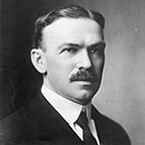
A noted pathologist and parisitologist, Ernest Tyzzer became interested in insects and parasites while growing up on his father’s farm in Wakefield, Massachusetts. He studied biology at Brown University (BS, 1897; MS, 1898). While in medical school at Harvard (MD, 1902), he spent summers trapping muskrat, fox, mink, and other animals to earn money for school. He found interesting parasites in the carcass of a fox, which he brought to the attention of William T. Councilman, professor of pathology, who encouraged his interest in the spectrum of infectious agents he found in indigenous small animals. An outbreak of smallpox in Boston in 1901 stimulated an interest in variola and was indirectly responsible for his classic contributions to the literature on the histopathology of varicella. In 1904, he and a colleague went to the Philippines to study smallpox and monkeys. At the time, smallpox and chickenpox were believed to be manifestations of the same disease. He disproved that theory, using the meticulous techniques that characterized his work.
Dr. Tyzzer returned to Boston and until 1916 served as director of research for the Harvard Cancer Commission, where he studied the relationship between immunity and cancer and wrote articles on genetic factors in neoplasia. In the early years of the AACR, he gave reports on the status of cancer research, from a personal perspective. These may have been the first AACR Progress Reports. He was AACR treasurer from 1908 to 1912 and AACR president in 1912; during his presidential term, the bylaws were ratified, and the association officially became the American Association for Cancer Research.
In 1916 Dr. Tyzzer was appointed Fabyan professor and head of the Department of Comparative Pathology at Harvard, a position he held until his retirement in 1942. He solved the riddle of the origins of blackhead disease in turkeys, which was destroying the turkey industry in Massachusetts. Dr. Tyzzer demonstrated the responsible organism was a flagellate, which he named Histomonas meleagrididis, and showed that disease followed ingestion of contaminated eggs of the nematodes. In 1942, he received a citation from the Massachusetts governor for saving the turkey industry of the state.
Dr. Tyzzer’s later research at Harvard included pioneering studies on the blood parasites of indigenous rodents, especially the field vole. He was elected in 1942 to the National Academy of Sciences, the American Academy of Arts and Sciences, and the American Philosophical Society. He was elected president of the American Society of Parasitologists in 1954. Throughout his life he made time for his avocation—collecting and cataloging Native American artifacts—which also began in early life on his father’s farm.